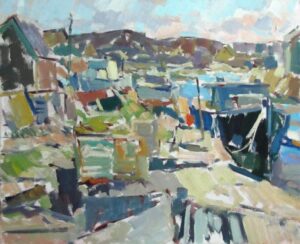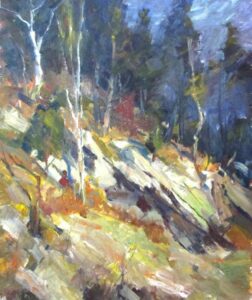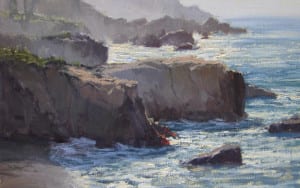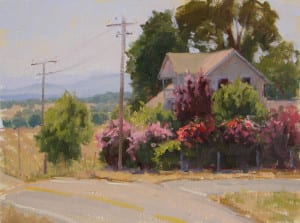At one of my always stimulating dinners with my late friend Zyg Jankowski, he said to me that the first decision a painter has to make about his work is a spacial one: how “deep” do you want to make the picture? John Carlson felt that every foot into nature counted; Ed Whiney had no interest in such realistic depth and recommended a student plan the composition on-site but walk around a corner to paint it. Over the years, I’ve been schizophrenic about the question. Under Emile Gruppe’s tutelage, I naturally followed Carlson’s path. Later, I experimented with a flatter approach , one which, carried to an extreme, can make the subject disappear in a series of flat planes.



Note: for a further discussion of these points, check out YouTube:
Oil Painting
My Method and Attitude Toward Art

I was once with a publishing company in New York. As with most illustrative work, I was told what to paint. I didn’t enjoy that part of my career. I finally gave it up.
I love painting landscapes, still life, and portraits. I usually have several paintings going at one time so I can go from one painting that’s too wet to continue, then pick up another painting that’s dry and continue painting on it. The second painting may be an entirely different subject matter so I’m always doing something different. Working this way helps keep me in a fresh state of mind.
I have my own studio apart from the house and am found there almost every day. I get such a sense of peace when surrounded by my art materials, my books and the smell of oil paint. If I’m not in a mood to paint, I get in the mood when I open the door. The outside world disappears. The light comes through the windows and doors and creates a warm glow on the knotty pine floor and I’m in my world. I have a CD player that keeps me company with Audio books checked out from the local libraries. My two faithful companions, Buddy-the Pomeranian mix, and Daisy-the Besinju, are always outside the door keeping watch.
My method of painting is done in layers. I start with a rough mono-chromatic under painting, keeping the paint thin and loose by adding turpentine to the paint. Being thin, it dries fast. I can then start adding thin layers of color. (I’m not a fast painter.) I am constantly correcting the painting as it progresses so I keep the paint thin until I get close to finishing it. I can then add thicker paint as needed.

In addition to painting as often as I can, I teach an all day Oil Painting Class once a month. Teaching is a great learning tool for me. I have to keep my skills honed in order to convey technique and theory to my students.
Life sometimes interrupts my painting time, but I don’t resent it. I love my family and friends and being constantly secluded in my studio would not be healthy for me and my spirit would suffer. Life first, art second.
Preserving My Dreams
 Ola! What a great idea, and how much I enjoy and grow and am empowered by reading the thoughts, musings, and experiences of these real and great painters.
Ola! What a great idea, and how much I enjoy and grow and am empowered by reading the thoughts, musings, and experiences of these real and great painters.
Reading Alan Wolton’s post (once I drove from Nashville to an obscure barn way outside of Chicago to see this extraordinary collection of his water lilies)what a great blessing to see inside his mind a little about layering in those transparent washes, and then to preserve them – discipline. This struck a chord in me (finally?).
About the same time I was going through Architectural Digest – and there was this painting on a bedroom wall (Brooke Shields) of a woman’s head study, all in black, and white, basically a beautiful value study. She wasn’t framed, looked half finished and is exquisite.

I think that the key for me, the only hope is in being present, moment by moment, choice by choice, focus, discipline. To decide truthfully as I see it. What is my darkest dark, my lightest light, and focus; remain focused on the goal of preserving that value scale.
“A man is what he thinks about all day long.” – Emerson
Frank Loyd Wright has inscribed on the beams of his studio, “What a man does, he has”.
“For as he thinketh in his heart, so is he”. – Proverbs 23:7
What I’m thinking about when I’m painting is what I’m going to create.
This discipline, sustained focus for me, is the key to producing not only work I love but a life I want to live.
I’ve worked out with a trainer (I must be forced) for most of the last 7 years. I want to be strong, but mainly I go for the discipline. I know that if while doing the plank, or attempting push-ups, if I ALLOW myself the luxury of a negative thought I will drop. My strength truly drops 30% because of what I’m thinking. So, whether it’s dieting, exercising, being kind to our mates and small animals, not eating that bowl of cereal at 11p.m, or holding onto that brilliant, childlike elusive transparent under-painting…
I’ve got to stay focused and hold onto the reality of what I think about, I bring about.
Self Improvement

Is art just a pleasant hobby? Or, is the goal is to become the best artists we can be? If so, how?
Think of the game of golf. The high handicapper plays round after round… with little improvement; the touring pro practices in order to elevate his game. Tiger Woods is renowned for playing 18 holes in a tournament and then going straight to the practice range to fine tune.
The best artists set aside time for self-improvement. Practice doesn’t make perfect… “perfect practice makes perfect.” Or as my friend Dan Gerhartz says, “Attack your weakness.” Isolate the problem area and work on it. In other words, set up a self-study program. Here are some things you can do:
Drawing (proportion or shape)
- Copy heads from the makeup ads in Seventeen or Alluremagazines. HINT:
- measure
the proportions on the reference and use the same relative proportions on your drawing.
- Get the Bargue / Gerome book, Drawing Course (Dover Press carries it). Copy the drawings. These are the plates used to prepare students for the French Academy des Beaux Artes.
- Join a sketch group in your area.

Values
- Make some full-value drawings of a plaster cast using one light source. (Squint to simplify the values.)
- Paint a monochromatic head study (use terra rosa and wipe out the lights with a rag…you may need to use some mineral spirits on a q-tip to get the highlights)
- De-saturate an image of a Sargent or Zorn painting and copy it in raw umber and white in five values.
Color
- Make color charts. Richard Schmid describes how to do them in his book, Alla Prima (NOTE: You can’t just look at them; you have to actually make them yourself to get any benefit.)
- Google “Henry Hensche”. Find a description of his training exercises and do them. The more you do these exercise, the more sensitive your color perception will become.

Edge control
- Squint, squint squint!!! Identify the sharpest edge on your subject (while squinting) and compare all other edges to it. If you can’t see a clear edge when you squint, don’t put one in your painting.
- Copy a head by Fechin.
Design / Composition
- Find a copy of Creative Illustration by Andrew Loomis and study the sections on composition (Google him; there’s a site where you can download the book.)
- Buy Edgar Payne’s Composition of Outdoor Painting. Copy the “design stems”
- I have released a DVD called Composition Secrets of the Masters that includes a number of exercises. It is available at www.lilipubs.com

One final thought: paint as much as you can from life (even though many of the above exercises rely on photos.) The camera lies! In a photo, values, edges, and color temperature are always wrong and half the time the proportions are off as well. In other words at least 3 of the 4 elements of representational painting are wrong in a photo reference. Read what your favorite artists have to say on the subject; the pros work mostly from life, amateurs often work mostly from photos.
Good luck and happy painting!
Why I Paint En Plein Air

The answer is simple: no painting done from a photo can ever compare to the energy, immediacy, and sense of place that can come through in a plein air piece. Somehow the feel of the day, be it heat or cold or wind or just a perfectly pleasant morning, makes its way down the arm and off the brush and onto the canvas. I wish I knew how it happens so I could fake that quality in the studio, but that’s the magic of plein air. Our experience comes out on the canvas. All our senses help to create the painting, not just our vision. We hear the cows lowing, we feel the breeze, we smell the hay…..it’s all there on the canvas. Even my worst plein air pieces have some small element of that particular day in them. I feel like I’m recording a moment in history: it will never be July 28, 2011 at 6:00 in the morning ever again in the history of the world, but now I have a little bit of it on canvas. How exciting is that?
Not all of my paintings are completed on location, and I paint many larger works entirely in the studio. But every piece I paint has its genesis in plein air studies. Working solely from photos leaves my paintings looking flat and unexciting. I use my reference photos to jog my memory or to help me come up with better designs that I may have overlooked when I was on location. But I can’t tell you how many times I’ve discarded a studio painting because I didn’t have enough plein air information on the scene to make the painting look convincing and alive. All the answers are outside, and even the most frustrating day of plein airing brings a more acute awareness of the subtleties of painting from life. Those skills honed outside make the studio work that much easier and fun.
